Global Diagnostic Imaging Services Market Forecast
- Global demand for diagnostic imaging services to soar high at a sustained CAGR of 4.6% over 2023 - 2030
- Market revenue likely to reach US$501.1 Bn by 2030, up from its 2022 valuation, i.e., US$365.8 Bn
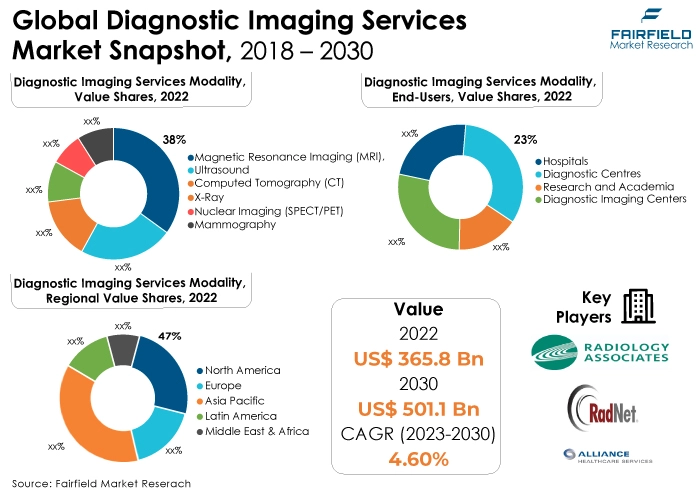
Quick Report Digest
- The key trend anticipated to fuel the growth of diagnostic imaging services is the increasing demand from the healthcare industry.
- The diagnostic imaging services market is growing due to increasing demand for advanced diagnostic technologies, rising prevalence of diseases requiring imaging, ongoing technological innovations, and expanding healthcare access, particularly in emerging markets, which collectively drive the need for diagnostic imaging services.
- The rising geriatric population is driving the diagnostic imaging services market as older individuals have a higher likelihood of developing age-related diseases that necessitate frequent diagnostic imaging for early detection, monitoring, and treatment, contributing to increased demand for these services.
- Magnetic resonance imaging (MRI) has captured the largest share in the diagnostic imaging services market due to its non-invasive nature, high-quality imaging capabilities, and versatility in diagnosing a wide range of medical conditions, including neurological, musculoskeletal, and cardiovascular disorders, making it a preferred choice for both patients and healthcare providers.
- Hospitals have captured the largest market share in the diagnostic imaging services market because they serve as comprehensive healthcare centres, offering a wide range of diagnostic services under one roof. They cater to diverse patient populations, necessitating a high demand for imaging services, contributing to their dominant market position.
- North America has secured the largest market share in the diagnostic imaging services market due to its robust healthcare infrastructure, high healthcare expenditure, stringent regulatory standards, growing ageing population, and a high prevalence of chronic diseases, which collectively drive demand for diagnostic imaging services in the region.
- The Asia Pacific region is experiencing the fastest CAGR in the diagnostic imaging services market due to its expanding population, increasing healthcare investments, rising disposable incomes, improving healthcare infrastructure, and a growing awareness of preventive healthcare, driving greater demand for diagnostic services in the region.
- Regulatory compliance challenges the diagnostic imaging services market by imposing strict standards on equipment, data privacy, and quality. Adherence requires significant resources, impacts workflow efficiency, and necessitates continuous adaptation to evolving regulations, potentially increasing operational costs for providers.
A Look Back and a Look Forward - Comparative Analysis
The diagnostic imaging services market is growing due to several factors, including an ageing population that requires more medical imaging for diagnosis and monitoring, technological advancements that improve imaging accuracy and efficiency, and increasing healthcare expenditures globally, leading to higher demand for diagnostic services. Additionally, the rising prevalence of chronic diseases necessitates frequent imaging for early detection and treatment planning, further fuelling market growth.
The market witnessed staggered growth during the historical period 2018 – 2022. This is due to the substantial growth of the major end-use application sectors, such as Hospitals. Hospitals are a growing end-user in the diagnostic imaging services market due to increasing patient volumes, the need for advanced diagnostic capabilities, and the trend toward centralised healthcare facilities. Hospitals rely on diagnostic imaging to diagnose and treat various medical conditions, driving the market's growth.
The future of the diagnostic imaging services market is promising, with ongoing technological innovations enhancing imaging modalities, such as AI-driven image analysis and 3D printing. This will improve diagnostic accuracy, speed, and accessibility. Telemedicine integration will enable remote image interpretation. Furthermore, as global healthcare needs continue to rise, the market is expected to expand, driven by increased demand for advanced diagnostic services and personalised medicine.
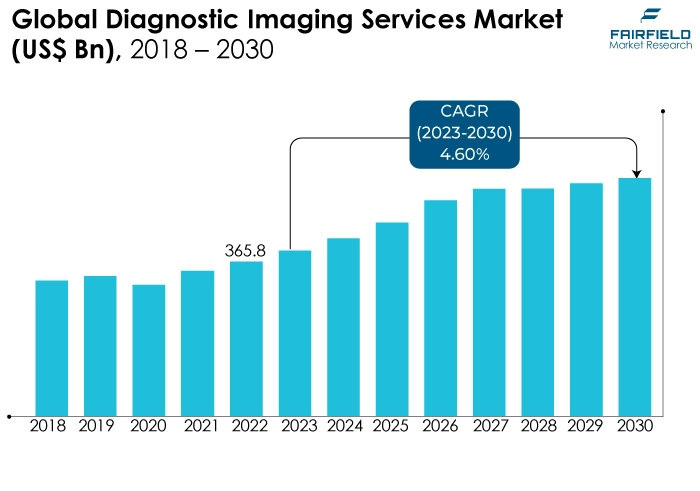
Key Growth Determinants
- Expanding Geriatric Population
The rising geriatric population is a significant driver of the diagnostic imaging services market. As people age, there is a higher likelihood of developing chronic and age-related diseases that require frequent diagnostic imaging for early detection and monitoring. This demographic shift leads to increased demand for services such as X-rays, MRIs, and CT scans.
Moreover, older individuals often require more comprehensive and specialised imaging, contributing to market growth as healthcare systems adapt to meet the unique needs of this demographic.
- Growing Intervention of AI and Blockchain in Diagnostics
The adoption of AI and blockchain technology is driving the diagnostic imaging services market by enhancing efficiency, accuracy, and security. AI aids in image analysis, enabling faster and more precise diagnoses. It also assists in workflow optimisation and patient management.
Blockchain ensures data integrity and security, which is crucial in handling sensitive patient information. Together, these technologies streamline operations, reduce costs, and improve patient care, making healthcare providers more inclined to invest in diagnostic imaging services, thereby fuelling market growth.
- Increasing Healthcare Expenditure
Increasing healthcare expenditure is a significant driver of the diagnostic imaging services market. As countries allocate more funds to healthcare, there's a greater capacity to invest in advanced imaging technologies and services. This leads to the acquisition of state-of-the-art diagnostic equipment, the expansion of imaging facilities, and the recruitment of skilled professionals.
Patients benefit from improved access to high-quality imaging, while healthcare providers can offer more comprehensive diagnostic services, all of which contribute to the market's growth.
Major Growth Barriers
- Shortage of Skilled Workforce
The diagnostic imaging services market faces challenges due to a shortage of skilled workforce. As demand for imaging services grows, there is an increasing need for radiologists, technicians, and support staff.
However, the supply of trained professionals often needs to catch up, leading to longer wait times for imaging procedures, potential errors, and reduced patient access. This shortage also drives up labour costs and hinders the implementation of advanced technologies. Addressing this workforce gap is crucial for sustaining and expanding the diagnostic imaging services sector.
- Regulatory Compliance
Regulatory compliance poses challenges to the diagnostic imaging services market. Stricter guidelines and quality standards demand adherence, which can lead to increased operational costs and complexities. Ensuring patient data privacy and security in compliance with regulations like HIPAA requires significant resources.
Additionally, evolving regulations and accreditation requirements necessitate continuous adaptation, potentially impacting workflow efficiency. Non-compliance can result in fines and legal repercussions. To thrive in this environment, providers must invest in compliance measures and stay updated with changing regulations, which can be resource-intensive.
Key Trends and Opportunities to Look at
- Portable and Point-of-Care Imaging
Portable and point-of-care imaging technology in the diagnostic imaging services market involves compact and mobile devices that enable on-the-spot imaging at the patient's bedside or in remote locations. These technologies provide quick access to diagnostic services, reducing the need for patients to travel to imaging centres. They are especially valuable in emergencies, rural healthcare settings, and for monitoring patients with mobility limitations, improving overall healthcare accessibility and efficiency.
- Cloud-Based Solutions
Cloud-based solutions in the diagnostic imaging services market involve storing, managing, and sharing medical images and data securely on remote servers. This technology offers scalability, accessibility, and remote collaboration among healthcare professionals. It enhances efficiency by enabling rapid access to images from anywhere, facilitates second opinions, and supports telemedicine. Additionally, it streamlines data management, reduces costs, and ensures data integrity and backup, making it a valuable asset in modern healthcare settings.
- Telemedicine Integration
Telemedicine integration in the diagnostic imaging services market involves incorporating diagnostic imaging capabilities into telehealth platforms. This technology enables remote consultations with healthcare providers, allowing patients to receive real-time interpretation and guidance on their imaging results from the comfort of their homes. It enhances healthcare accessibility, reduces the need for in-person visits, and supports timely diagnosis and treatment planning, especially in remote or underserved areas.
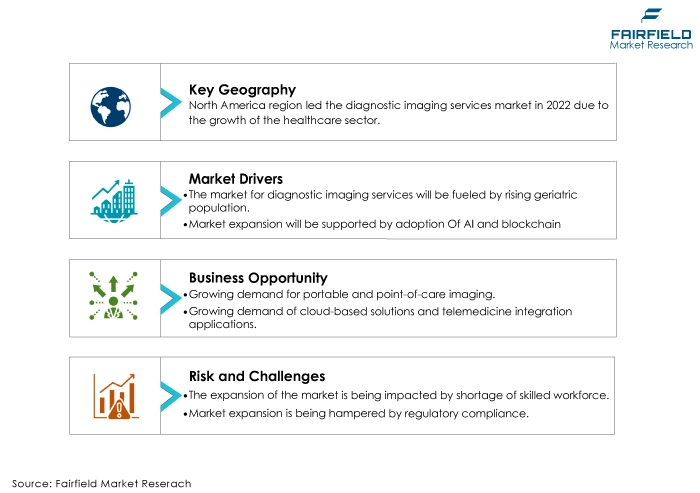
How Does the Regulatory Scenario Shape this Industry?
The regulatory scenario significantly shapes the diagnostic imaging services market by ensuring quality, safety, and data privacy. Regulatory bodies, such as the FDA in the United States, impose stringent standards for equipment performance, radiation safety, and image quality, which influence the development and adoption of imaging technologies. Compliance with healthcare data regulations, like HIPAA, is crucial for protecting patient privacy in the handling and sharing of medical images.
Moreover, reimbursement policies and insurance coverage decisions impact the affordability and accessibility of imaging services for patients. Changes in regulations can drive innovation as companies strive to meet new compliance requirements and improve patient outcomes. Regulatory approval is essential for market entry and can influence the competitive landscape. Therefore, the regulatory environment plays a pivotal role in shaping the evolution, quality, and accessibility of diagnostic imaging services.
Fairfield’s Ranking Board
Top Segments
- MRI Remains the Dominant Modality
Magnetic resonance imaging (MRI) has captured the largest share in the diagnostic imaging services market due to its non-invasive, radiation-free nature and its ability to provide detailed images of soft tissues, organs, and the central nervous system. MRI's versatility, high-quality images, and safety make it suitable for diagnosing a wide range of conditions, including neurological, musculoskeletal, and cardiovascular disorders.
Continuous technological advancements, such as higher field strengths and functional MRI, further enhance its diagnostic capabilities. Its widespread adoption across various medical specialties has propelled MRI to the forefront of diagnostic imaging services, contributing to its dominant market share.
Computed Tomography (CT) is experiencing the highest Compound Annual Growth Rate (CAGR) in the diagnostic imaging services market due to several factors. CT scans offer rapid imaging with exceptional detail, making them valuable for diagnosing a broad spectrum of medical conditions, from trauma to cancer.
Continuous advancements, including multi-slice and cone-beam CT, enhance speed and image quality. CT also plays a crucial role in emergency medicine and oncology, driving its demand. Moreover, the rising prevalence of chronic diseases necessitates frequent monitoring, further boosting CT's growth in the market.
- Hospitals Surge Ahead in Adoption
Hospitals have captured the largest market share in the diagnostic imaging services market due to several reasons. First, hospitals serve as comprehensive healthcare centres, making them primary hubs for diagnostic imaging services. Second, they cater to a diverse patient population with varying medical needs, leading to a high demand for imaging services.
Additionally, hospitals often invest in advanced imaging equipment and facilities to provide a wide range of diagnostic services under one roof, making them a preferred choice for both patients and referring physicians and contributing to their dominant market share.
Diagnostic imaging centres are experiencing the fastest CAGR in the diagnostic imaging services market for several reasons. They offer specialised expertise, state-of-the-art equipment, and shorter wait times, making them attractive for patients seeking efficient and precise diagnostics.
The trend towards outpatient care and the increasing emphasis on cost-effective healthcare solutions contribute to their growth. Furthermore, diagnostic imaging centres often have a dedicated focus on imaging services, allowing them to stay at the forefront of technology and offer a wide array of specialised imaging modalities, further driving their market expansion.
Regional Frontrunners
North America Leads the Way
North America has captured the largest market share in the diagnostic imaging services market for several reasons. The region benefits from robust healthcare infrastructure, advanced medical technology, and high healthcare expenditure, enabling widespread access to diagnostic imaging services.
A well-established regulatory framework ensures quality, safety, and data privacy, instilling confidence in patients and healthcare providers. Moreover, North America has a growing ageing population, leading to increased demand for diagnostic imaging in the diagnosis and management of age-related diseases. The region also exhibits a high prevalence of chronic conditions, necessitating frequent imaging for timely intervention.
A strong focus on research and development, along with the presence of leading healthcare institutions and innovative companies, continually drives technological advancements and market growth. These factors collectively contribute to North America's dominance in the diagnostic imaging services market.
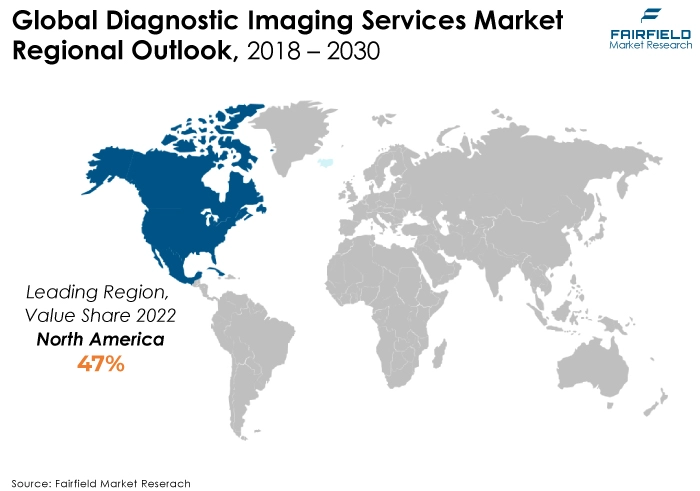
Market Attractiveness of Asia Pacific to Rise
The Asia Pacific region is experiencing the highest growth rate in the diagnostic imaging services market due to several factors. The region's expanding population, increasing healthcare investments, and rising disposable incomes are driving greater demand for diagnostic services. Moreover, improving healthcare infrastructure, technological advancements, and growing awareness of preventive healthcare contribute to market growth.
In addition, the prevalence of chronic diseases in the region necessitates frequent imaging for diagnosis and management. As a result, the Asia Pacific region is witnessing rapid expansion in the diagnostic imaging services sector, leading to its impressive CAGR in the market.
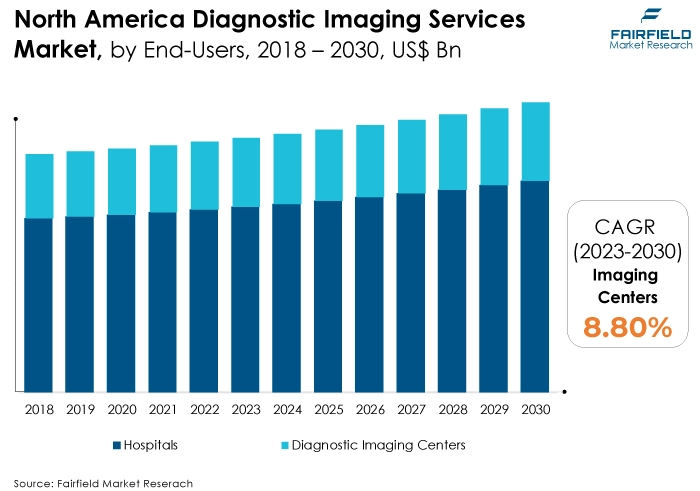
Fairfield’s Competitive Landscape Analysis
The global diagnostic imaging services market is consolidated, with fewer major players present globally. The key players are introducing new products and working on the distribution channels to enhance their worldwide presence. Moreover, Fairfield Market Research expects more consolidation over the coming years.
Who are the Leaders in the Global Diagnostic Imaging Services space?
- Radiology Associates, Inc
- RadNet, Inc.
- Alliance Healthcare Services, Inc.
- Sonic Healthcare Limited
- Envision Healthcare Corporation
- Alliance Medical Group
- InHealth Group
- Center for Diagnostic Imaging (CDI)
- SimonMed Imaging
- National Imaging Associates (NIA)
- Mednax, Inc.
- Akumin Inc.
- Zwanger-Pesiri Radiology Group
- Touchstone Medical Imaging
- Insight Imaging
Key Company Developments
New Product Launches
- July 2022: Canon Medical introduced the Vantage Fortain MRI System during ECR 2022. This MRI system incorporates inventive workflow solutions, image enhancements, and accelerated scan technology, collectively reducing the duration of MRI procedures.
- December 2021: Fujifilm Healthcare introduced the Velocity MRI system, an advanced high-field open MRI, at the 2021 Radiological Society of North America conference in Chicago.
Distribution Agreement
- April 2022: Wipro GE Healthcare unveiled the next-generation Revolution Aspire CT scanner, an advanced imaging solution entirely conceived and produced in India.
An Expert’s Eye
Demand and Future Growth
The growth of the healthcare industry is driving the market. The diagnostic imaging services market is experiencing increasing demand and is poised for significant future growth. The factors driving this growth include an ageing population, rising prevalence of chronic diseases, technological advancements, and the need for early and accurate diagnosis.
In addition, the integration of AI, and telemedicine, along with expanding healthcare access in emerging markets, further fuel market expansion. The future holds promise with continuous innovation in imaging technologies, enhancing the scope and efficiency of diagnostic services leading to sustained growth in the industry.
Supply Side of the Market
The major countries in the diagnostic imaging services market include the United States, China, Japan, Germany, and India. The US leads the market due to its robust healthcare infrastructure and high healthcare expenditure. China, and India are rapidly growing markets driven by their large populations and increasing healthcare investments.
Japan, and Germany are prominent players known for their advanced imaging technologies and healthcare systems. These countries represent significant market shares and continue to shape the global landscape of diagnostic imaging services.
Raw materials required in the diagnostic imaging services market include specialised medical imaging equipment such as MRI machines, CT scanners, X-ray machines, ultrasound devices, and associated components like imaging sensors, contrast agents, and radiation shielding materials.
Prominent manufacturers in this market include Siemens Healthineers, General Electric Company, Philips Healthcare, Canon Medical Systems Corporation, Hitachi Healthcare, and Fujifilm Holdings Corporation. These companies produce a wide range of diagnostic imaging equipment and related materials used in healthcare facilities globally.
The Global Diagnostic Imaging Services Market is Segmented as Below:
By Modality:
- Magnetic Resonance Imaging (MRI)
- Ultrasound
- Computed Tomography (CT)
- X-Ray
- Nuclear Imaging (SPECT/PET)
- Mammography
By End User:
- Hospitals
- Diagnostic Imaging Centres
- Diagnostic Centres
- Research and Academia
By Geographic Coverage:
- North America
- U.S.
- Canada
- Europe
- Germany
- U.K.
- France
- Italy
- Turkey
- Russia
- Rest of Europe
- Asia Pacific
- China
- Japan
- South Korea
- India
- Southeast Asia
- Rest of Asia Pacific
- Latin America
- Brazil
- Mexico
- Argentina
- Rest of Latin America
- Middle East & Africa
- GCC
- South Africa
- Egypt
- Nigeria
- Rest of the Middle East & Africa
1. Executive Summary
1.1. Global Diagnostic Imaging Services Market Snapshot
1.2. Future Projections
1.3. Key Market Trends
1.4. Regional Snapshot, by Value, 2022
1.5. Analyst Recommendations
2. Market Overview
2.1. Market Definitions and Segmentations
2.2. Market Dynamics
2.2.1. Drivers
2.2.2. Restraints
2.2.3. Market Opportunities
2.3. Value Chain Analysis
2.4. Porter’s Five Forces Analysis
2.5. COVID-19 Impact Analysis
2.5.1. Supply
2.5.2. Demand
2.6. Impact of Ukraine-Russia Conflict
2.7. Economic Overview
2.7.1. World Economic Projections
2.8. PESTLE Analysis
3. Global Diagnostic Imaging Services Market Outlook, 2018 - 2030
3.1. Global Diagnostic Imaging Services Market Outlook, by Modality, Value (US$ Bn), 2018 - 2030
3.1.1. Key Highlights
3.1.1.1. Magnetic Resonance Imaging (MRI)
3.1.1.2. Ultrasound
3.1.1.3. Computed Tomography (CT)
3.1.1.4. X-Ray
3.1.1.5. Nuclear Imaging (SPECT/PET)
3.1.1.6. Mammography
3.2. Global Diagnostic Imaging Services Market Outlook, by End User, Value (US$ Bn), 2018 - 2030
3.2.1. Key Highlights
3.2.1.1. Hospitals
3.2.1.2. Diagnostic Imaging Centres
3.2.1.3. Diagnostic Centres
3.2.1.4. Research and Academia
3.3. Global Diagnostic Imaging Services Market Outlook, by Region, Value (US$ Bn), 2018 - 2030
3.3.1. Key Highlights
3.3.1.1. North America
3.3.1.2. Europe
3.3.1.3. Asia Pacific
3.3.1.4. Latin America
3.3.1.5. Middle East & Africa
4. North America Diagnostic Imaging Services Market Outlook, 2018 - 2030
4.1. North America Diagnostic Imaging Services Market Outlook, by Modality, Value (US$ Bn), 2018 - 2030
4.1.1. Key Highlights
4.1.1.1. Magnetic Resonance Imaging (MRI)
4.1.1.2. Ultrasound
4.1.1.3. Computed Tomography (CT)
4.1.1.4. X-Ray
4.1.1.5. Nuclear Imaging (SPECT/PET)
4.1.1.6. Mammography
4.2. North America Diagnostic Imaging Services Market Outlook, by End User, Value (US$ Bn), 2018 - 2030
4.2.1. Key Highlights
4.2.1.1. Hospitals
4.2.1.2. Diagnostic Imaging Centres
4.2.1.3. Diagnostic Centres
4.2.1.4. Research and Academia
4.2.2. BPS Analysis/Market Attractiveness Analysis
4.3. North America Diagnostic Imaging Services Market Outlook, by Country, Value (US$ Bn), 2018 - 2030
4.3.1. Key Highlights
4.3.1.1. U.S. Diagnostic Imaging Services Market, by Modality, Value (US$ Bn), 2018 - 2030
4.3.1.2. U.S. Diagnostic Imaging Services Market, by End User, Value (US$ Bn), 2018 - 2030
4.3.1.3. Canada Diagnostic Imaging Services Market, by Modality, Value (US$ Bn), 2018 - 2030
4.3.1.4. Canada Diagnostic Imaging Services Market, by End User, Value (US$ Bn), 2018 - 2030
4.3.2. BPS Analysis/Market Attractiveness Analysis
5. Europe Diagnostic Imaging Services Market Outlook, 2018 - 2030
5.1. Europe Diagnostic Imaging Services Market Outlook, by Modality, Value (US$ Bn), 2018 - 2030
5.1.1. Key Highlights
5.1.1.1. Magnetic Resonance Imaging (MRI)
5.1.1.2. Ultrasound
5.1.1.3. Computed Tomography (CT)
5.1.1.4. X-Ray
5.1.1.5. Nuclear Imaging (SPECT/PET)
5.1.1.6. Mammography
5.2. Europe Diagnostic Imaging Services Market Outlook, by End User, Value (US$ Bn), 2018 - 2030
5.2.1. Key Highlights
5.2.1.1. Hospitals
5.2.1.2. Diagnostic Imaging Centres
5.2.1.3. Diagnostic Centres
5.2.1.4. Research and Academia
5.2.2. BPS Analysis/Market Attractiveness Analysis
5.3. Europe Diagnostic Imaging Services Market Outlook, by Country, Value (US$ Bn), 2018 - 2030
5.3.1. Key Highlights
5.3.1.1. Germany Diagnostic Imaging Services Market, by Modality, Value (US$ Bn), 2018 - 2030
5.3.1.2. Germany Diagnostic Imaging Services Market, by End User, Value (US$ Bn), 2018 - 2030
5.3.1.3. U.K. Diagnostic Imaging Services Market, by Modality, Value (US$ Bn), 2018 - 2030
5.3.1.4. U.K. Diagnostic Imaging Services Market, by End User, Value (US$ Bn), 2018 - 2030
5.3.1.5. France Diagnostic Imaging Services Market, by Modality, Value (US$ Bn), 2018 - 2030
5.3.1.6. France Diagnostic Imaging Services Market, by End User, Value (US$ Bn), 2018 - 2030
5.3.1.7. Italy Diagnostic Imaging Services Market, by Modality, Value (US$ Bn), 2018 - 2030
5.3.1.8. Italy Diagnostic Imaging Services Market, by End User, Value (US$ Bn), 2018 - 2030
5.3.1.9. Turkey Diagnostic Imaging Services Market, by Modality, Value (US$ Bn), 2018 - 2030
5.3.1.10. Turkey Diagnostic Imaging Services Market, by End User, Value (US$ Bn), 2018 - 2030
5.3.1.11. Russia Diagnostic Imaging Services Market, by Modality, Value (US$ Bn), 2018 - 2030
5.3.1.12. Russia Diagnostic Imaging Services Market, by End User, Value (US$ Bn), 2018 - 2030
5.3.1.13. Rest of Europe Diagnostic Imaging Services Market, by Modality, Value (US$ Bn), 2018 - 2030
5.3.1.14. Rest of Europe Diagnostic Imaging Services Market, by End User, Value (US$ Bn), 2018 - 2030
5.3.2. BPS Analysis/Market Attractiveness Analysis
6. Asia Pacific Diagnostic Imaging Services Market Outlook, 2018 - 2030
6.1. Asia Pacific Diagnostic Imaging Services Market Outlook, by Modality, Value (US$ Bn), 2018 - 2030
6.1.1. Key Highlights
6.1.1.1. Magnetic Resonance Imaging (MRI)
6.1.1.2. Ultrasound
6.1.1.3. Computed Tomography (CT)
6.1.1.4. X-Ray
6.1.1.5. Nuclear Imaging (SPECT/PET)
6.1.1.6. Mammography
6.2. Asia Pacific Diagnostic Imaging Services Market Outlook, by End User, Value (US$ Bn), 2018 - 2030
6.2.1. Key Highlights
6.2.1.1. Hospitals
6.2.1.2. Diagnostic Imaging Centres
6.2.1.3. Diagnostic Centres
6.2.1.4. Research and Academia
6.2.2. BPS Analysis/Market Attractiveness Analysis
6.3. Asia Pacific Diagnostic Imaging Services Market Outlook, by Country, Value (US$ Bn), 2018 - 2030
6.3.1. Key Highlights
6.3.1.1. China Diagnostic Imaging Services Market, by Modality, Value (US$ Bn), 2018 - 2030
6.3.1.2. China Diagnostic Imaging Services Market by End User, Value (US$ Bn), 2018 - 2030
6.3.1.3. Japan Diagnostic Imaging Services Market, by Modality, Value (US$ Bn), 2018 - 2030
6.3.1.4. Japan Diagnostic Imaging Services Market, by End User, Value (US$ Bn), 2018 - 2030
6.3.1.5. South Korea Diagnostic Imaging Services Market, by Modality, Value (US$ Bn), 2018 - 2030
6.3.1.6. South Korea Diagnostic Imaging Services Market, by End User, Value (US$ Bn), 2018 - 2030
6.3.1.7. India Diagnostic Imaging Services Market, by Modality, Value (US$ Bn), 2018 - 2030
6.3.1.8. India Diagnostic Imaging Services Market, by End User, Value (US$ Bn), 2018 - 2030
6.3.1.9. Southeast Asia Diagnostic Imaging Services Market, by Modality, Value (US$ Bn), 2018 - 2030
6.3.1.10. Southeast Asia Diagnostic Imaging Services Market, by End User, Value (US$ Bn), 2018 - 2030
6.3.1.11. Rest of Asia Pacific Diagnostic Imaging Services Market, by Modality, Value (US$ Bn), 2018 - 2030
6.3.1.12. Rest of Asia Pacific Diagnostic Imaging Services Market, by End User, Value (US$ Bn), 2018 - 2030
6.3.2. BPS Analysis/Market Attractiveness Analysis
7. Latin America Diagnostic Imaging Services Market Outlook, 2018 - 2030
7.1. Latin America Diagnostic Imaging Services Market Outlook, by Modality, Value (US$ Bn), 2018 - 2030
7.1.1. Key Highlights
7.1.1.1. Magnetic Resonance Imaging (MRI)
7.1.1.2. Ultrasound
7.1.1.3. Computed Tomography (CT)
7.1.1.4. X-Ray
7.1.1.5. Nuclear Imaging (SPECT/PET)
7.1.1.6. Mammography
7.2. Latin America Diagnostic Imaging Services Market Outlook, by End User, Value (US$ Bn), 2018 - 2030
7.2.1.1. Hospitals
7.2.1.2. Diagnostic Imaging Centres
7.2.1.3. Diagnostic Centres
7.2.1.4. Research and Academia
7.2.2. BPS Analysis/Market Attractiveness Analysis
7.3. Latin America Diagnostic Imaging Services Market Outlook, by Country, Value (US$ Bn), 2018 - 2030
7.3.1. Key Highlights
7.3.1.1. Brazil Diagnostic Imaging Services Market, by Modality, Value (US$ Bn), 2018 - 2030
7.3.1.2. Brazil Diagnostic Imaging Services Market, by End User, Value (US$ Bn), 2018 - 2030
7.3.1.3. Mexico Diagnostic Imaging Services Market, by Modality, Value (US$ Bn), 2018 - 2030
7.3.1.4. Mexico Diagnostic Imaging Services Market, by End User, Value (US$ Bn), 2018 - 2030
7.3.1.5. Argentina Diagnostic Imaging Services Market, by Modality, Value (US$ Bn), 2018 - 2030
7.3.1.6. Argentina Diagnostic Imaging Services Market, by End User, Value (US$ Bn), 2018 - 2030
7.3.1.7. Rest of Latin America Diagnostic Imaging Services Market, by Modality, Value (US$ Bn), 2018 - 2030
7.3.1.8. Rest of Latin America Diagnostic Imaging Services Market, by End User, Value (US$ Bn), 2018 - 2030
7.3.2. BPS Analysis/Market Attractiveness Analysis
8. Middle East & Africa Diagnostic Imaging Services Market Outlook, 2018 - 2030
8.1. Middle East & Africa Diagnostic Imaging Services Market Outlook, by Modality, Value (US$ Bn), 2018 - 2030
8.1.1. Key Highlights
8.1.1.1. Magnetic Resonance Imaging (MRI)
8.1.1.2. Ultrasound
8.1.1.3. Computed Tomography (CT)
8.1.1.4. X-Ray
8.1.1.5. Nuclear Imaging (SPECT/PET)
8.1.1.6. Mammography
8.2. Middle East & Africa Diagnostic Imaging Services Market Outlook, by End User, Value (US$ Bn), 2018 - 2030
8.2.1. Key Highlights
8.2.1.1. Hospitals
8.2.1.2. Diagnostic Imaging Centres
8.2.1.3. Diagnostic Centres
8.2.1.4. Research and Academia
8.2.2. BPS Analysis/Market Attractiveness Analysis
8.3. Middle East & Africa Diagnostic Imaging Services Market Outlook, by Country, Value (US$ Bn), 2018 - 2030
8.3.1. Key Highlights
8.3.1.1. GCC Diagnostic Imaging Services Market, by Modality, Value (US$ Bn), 2018 - 2030
8.3.1.2. GCC Diagnostic Imaging Services Market, by End User, Value (US$ Bn), 2018 - 2030
8.3.1.3. South Africa Diagnostic Imaging Services Market, by Modality, Value (US$ Bn), 2018 - 2030
8.3.1.4. South Africa Diagnostic Imaging Services Market, by End User, Value (US$ Bn), 2018 - 2030
8.3.1.5. Egypt Diagnostic Imaging Services Market, by Modality, Value (US$ Bn), 2018 - 2030
8.3.1.6. Egypt Diagnostic Imaging Services Market, by End User, Value (US$ Bn), 2018 - 2030
8.3.1.7. Nigeria Diagnostic Imaging Services Market, by Modality, Value (US$ Bn), 2018 - 2030
8.3.1.8. Nigeria Diagnostic Imaging Services Market, by End User, Value (US$ Bn), 2018 - 2030
8.3.1.9. Rest of Middle East & Africa Diagnostic Imaging Services Market, by Modality, Value (US$ Bn), 2018 - 2030
8.3.1.10. Rest of Middle East & Africa Diagnostic Imaging Services Market, by End User, Value (US$ Bn), 2018 - 2030
8.3.2. BPS Analysis/Market Attractiveness Analysis
9. Competitive Landscape
9.1. Manufacturer vs Application Heatmap
9.2. Company Market Share Analysis, 2022
9.3. Competitive Dashboard
9.4. Company Profiles
9.4.1. Radiology Associates, Inc
9.4.1.1. Company Overview
9.4.1.2. Product Portfolio
9.4.1.3. Financial Overview
9.4.1.4. Business Strategies and Development
9.4.2. RadNet, Inc.
9.4.2.1. Company Overview
9.4.2.2. Product Portfolio
9.4.2.3. Financial Overview
9.4.2.4. Business Strategies and Development
9.4.3. Alliance Healthcare Services, Inc.
9.4.3.1. Company Overview
9.4.3.2. Product Portfolio
9.4.3.3. Financial Overview
9.4.3.4. Business Strategies and Development
9.4.4. Sonic Healthcare Limited
9.4.4.1. Company Overview
9.4.4.2. Product Portfolio
9.4.4.3. Financial Overview
9.4.4.4. Business Strategies and Development
9.4.5. Envision Healthcare Corporation
9.4.5.1. Company Overview
9.4.5.2. Product Portfolio
9.4.5.3. Financial Overview
9.4.5.4. Business Strategies and Development
9.4.6. Alliance Medical Group
9.4.6.1. Company Overview
9.4.6.2. Product Portfolio
9.4.6.3. Financial Overview
9.4.6.4. Business Strategies and Development
9.4.7. InHealth Group
9.4.7.1. Company Overview
9.4.7.2. Product Portfolio
9.4.7.3. Financial Overview
9.4.7.4. Business Strategies and Development
9.4.8. Center for Diagnostic Imaging (CDI)
9.4.8.1. Company Overview
9.4.8.2. Product Portfolio
9.4.8.3. Financial Overview
9.4.8.4. Business Strategies and Development
9.4.9. SimonMed Imaging
9.4.9.1. Company Overview
9.4.9.2. Product Portfolio
9.4.9.3. Financial Overview
9.4.9.4. Business Strategies and Development
9.4.10. National Imaging Associates (NIA)
9.4.10.1. Company Overview
9.4.10.2. Product Portfolio
9.4.10.3. Financial Overview
9.4.10.4. Business Strategies and Development
9.4.11. Mednax, Inc.
9.4.11.1. Company Overview
9.4.11.2. Product Portfolio
9.4.11.3. Financial Overview
9.4.11.4. Business Strategies and Development
9.4.12. Akumin Inc.
9.4.12.1. Company Overview
9.4.12.2. Product Portfolio
9.4.12.3. Financial Overview
9.4.12.4. Business Strategies and Development
9.4.13. Zwanger-Pesiri Radiology Group
9.4.13.1. Company Overview
9.4.13.2. Product Portfolio
9.4.13.3. Financial Overview
9.4.13.4. Business Strategies and Development
9.4.14. Touchstone Medical Imaging
9.4.14.1. Company Overview
9.4.14.2. Product Portfolio
9.4.14.3. Financial Overview
9.4.14.4. Business Strategies and Development
9.4.15. Insight Imaging
9.4.15.1. Company Overview
9.4.15.2. Product Portfolio
9.4.15.3. Financial Overview
9.4.15.4. Business Strategies and Development
10. Appendix
10.1. Research Methodology
10.2. Report Assumptions
10.3. Acronyms and Abbreviations
|
BASE YEAR |
HISTORICAL DATA |
FORECAST PERIOD |
UNITS |
|||
|
2022 |
|
2018 - 2022 |
2023 - 2030 |
Value: US$ Million |
||
|
REPORT FEATURES |
DETAILS |
|
Modality Coverage |
|
|
End User Coverage |
|
|
Geographical Coverage |
|
|
Leading Companies |
|
|
Report Highlights |
Key Market Indicators, Macro-micro economic impact analysis, Technological Roadmap, Key Trends, Driver, Restraints, and Future Opportunities & Revenue Pockets, Porter’s 5 Forces Analysis, Historical Trend (2019-2021), Market Estimates and Forecast, Market Dynamics, Industry Trends, Competition Landscape, Category, Region, Country-wise Trends & Analysis, COVID-19 Impact Analysis (Demand and Supply Chain) |
